
 |
|
Our Data...Organisms |
|
Open Ocean |
|
|
We had a beautiful day to visit our open ocean station in the Sargasso Sea. The dolphins thought so too! We even had some time to catch some Mahi Mahi - you know what's on the menu for dinner this evening! |
 |
| The Sargasso Sea is well known for the floating mats of Sargassum weed (right). Using a simple mesh net, we grabbed a sample and found a "floating city" full of crabs, small fish and shrimp (below). Poor swimmers must maintain a firm grip on these floating mats or be lost to the ocean depths. Notice how members of the Sargassum weed ecosystem blend in with the tan Sargassum weed. |
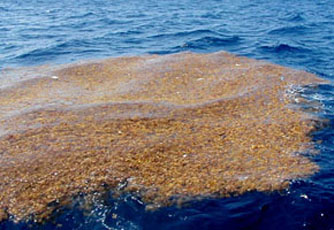 |
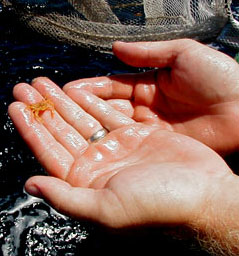 |
|
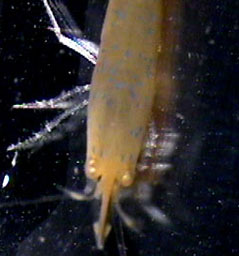 |
| Sargassum weed often has a hard, whitish coating that may help protect against predation.
|
Air sacs and delicate fan-like extensions keep the Sargassum afloat. |
| Our net tows at the open ocean station seemed pretty empty compared to our upwelling station tows. One species we did find in our tows was Trichodesmium, a common cyanobacteria ("blue-green algae") in tropical to subtropical waters. It exists as single "filaments"...
|
|
| ... or as colonies (20 - 200 "filaments"). Colonies may be visible to the unaided eye (1-10 mm in length).
|
|
|
|
Pyrocystis noctiluca is a bioluminescent dinoflagellate (left). Ceratium
is another dinoflagellate that was found in our open ocean net tows
(right). |
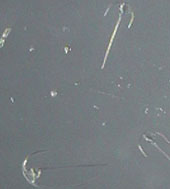 |
|
Although infrequently observed, some chain diatoms were discovered in our tows (right).
|
|
|
|
Unusual blue copepods were sampled... why might copepods that live in the Sargasso Sea have this color? Pictured to the right is a copepod nauplii (next to a Trichodesmium filament), a "favorite food" for larvae-eaters. |
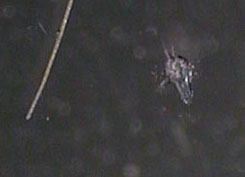 |
| Enchinoderm larvae have distinctive shapes (below). |
The "snail-like" organism (above, middle) is likely Foraminifera, an amoeba with a calcareous shell. To its right is Tintinnid, a ciliate that feeds on small phytoplankton. |
The star-shaped organisms (below) are radiolaria - amoebae that have symbiotic relationships with phytoplankton.
|
| Our slide-making some nanoplankton....
|
.....and some picoplankton.
|
|
In addition to the organisms we were able to photograph, we also saw some squid, some jellyfish, and even some flying fish! |